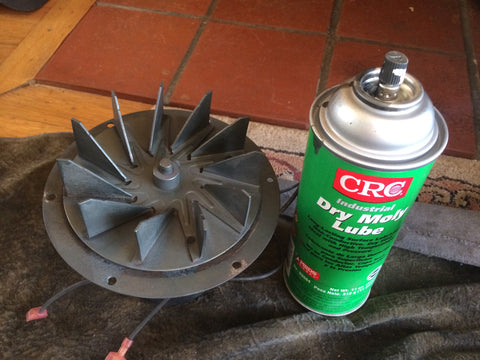The pellet stove exhaust blower pulls air into the burn pot for combustion. It then pulls the heated air across the heat exchanger and pushes the air and smoke up and out the flue venting. A blower in top condition produces optimum combustion, completely burning your pellets and providing cozy heat.
Therefore, your exhaust blower should be cleaned and lubricated at least once per year. If the exhaust blower is faulty, replace it and you'll see a difference.
My video shows a bad blower with a seized bearing and a blower with a noisy case and demonstrates the best upgraded replacement.
To review, the number two light indicates there is not enough vacuum to hold the vacuum switch in or keep it engaged. This is a sign that the exhaust blower needs replacement. If the exhaust blower doesn't push enough air, there won't be enough vacuum. Performing a spin test is a simple way of determining what's wrong. As seen in my video the difference between a functioning blower and one with a jammed bearing is clear. It is also important to listen to the sounds the blower is making. It may indicate a rattling cage. Listen to the sound in my video. If you hear that, it's a strong indicator that your blower may need replacement. I highly recommend the "Low Drafter" exhaust blower. It's larger blades move more air at a lower heat level, hence it's name. This way the pellets burn more completely. It's also 1.75 amp versus the usual 1 amp. You could hear it whirring in my video and tell how powerful it is, but it's still quiet enough not to disturb you're household. You can also see the ball bearings for yourself. It is sturdily built! Click here to view that blower:
http://www.eastcoasthearth.com/search?q=low+drafter
If your exhaust blower still runs well, you can clean it to keep it in top shape. All you need is some dry moly spray, light weight machine oil, a putty knife, a brush, and some wire wheel drill bits. See my pictures below. Using a putty knife and wide wire bristle brush frees up most of the caked on ash. The cylindrical brush is about as thick as a pipe cleaner, which is perfect for cleaning underneath the blade. The wire wheels are best for cleaning over the blades to remove finer dirt and residue. The cylindrical wire wheel is best for getting inside the corners, while the round wire wheel provides the most scrubbing power. Dry Moly helps stop the build up of ash and makes it easier to clean the blower next year. Just follow the steps below to remove and clean the blower:
1. To remove the exhaust blower, unclip 2 or 3 wires depending on how many your blower has.
2. Unbolt 6 nuts or bolts depending on which your stove has, then pull out the exhaust blower.
3. Scrape under blades with a putty knife. Remove the rest of the caked on ash with a wide wire brush like the one below.

4. Scrub under the blades and the motor shaft with a cylindrical wire brush.
5. Using the drill, scrub the tops of the blades with the wire wheel drill bits.


6. Oil the motor and motor shaft.
7. Spray Dry Moly on the impeller blades.
8. Install a new White Lytherm High Temperature Gasket.
9. Bolt in the blower and clip the wires back together.
This lube kit can be used to get the job done:
http://www.eastcoasthearth.com/products/oil-lube-dry-moly-spray-pellet-stove-lubrication-kit
Here's a convenient little oil bottle for your 3-1 light weight machine oil. It has a narrow spout good for getting into small spaces.
http://www.eastcoasthearth.com/products/pellet-stove-master-pellet-stove-oil-bottle














